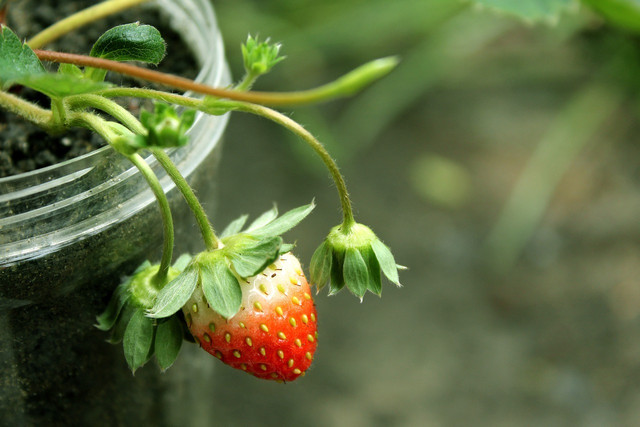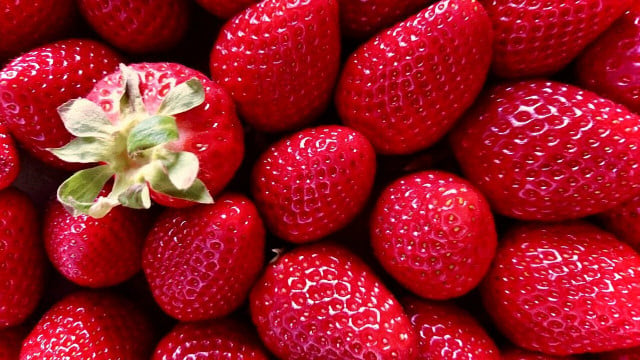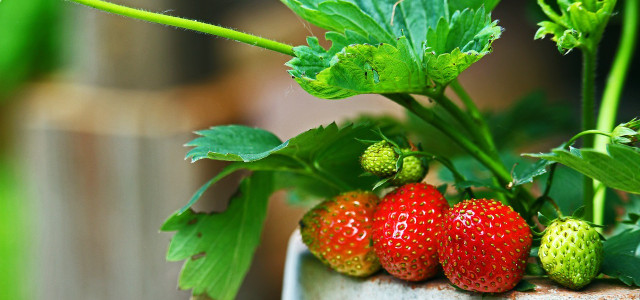Wondering how to grow strawberries indoors? If you love berries and prefer homegrown fruits, read on for tips on how to grow and care for your strawberry plants in your apartment.
There’s nothing like homegrown fresh fruit to have as a snack, especially if you pick them right before eating them. Whether you lack outdoor space or simply enjoy indoor gardening, strawberries are probably one of the easiest fruits you can grow in your kitchen. This sweet fruit is already so delicious when eaten on its own, but you can also use for a quick fruit salad recipe, as a topping for some vegan yogurt, or to go with your morning proats or vegan baked oats. On top of that, homegrown strawberries have way better flavor than those bought at a supermarket, and you know that no pesticides were used in the harvesting process!
How to Grow Strawberries Indoors: Step by Step



(Foto: CC0 / Pixabay / senjakelabu29)
Before you grow your strawberry plants, you will need to decide whether you want to grow them from seed or purchase seedling plants from a local nursery. If you grow them from scratch, it will take between five and six months for the plant to produce berries. On the other hand, if you plant baby strawberry plants, they can produce fruit in about two months. If you’ve been wanting to learn how to grow strawberries indoors and you are up for the challenge, gather your supplies, and let’s start planting!
Things You’ll Need:
- Organic Potting Soil: Make sure it is organic, otherwise it will contain pesticides that are not eco-friendly and could harm your plant.
- Strawberry Plant Container: Strawberries have very shallow roots, meaning that you don’t need a deep container and that you can grow several plants together in the same pot. We recommend you pick a wide, six to eight-inch deep pot. You’ll want to have enough space to leave between three and four inches between each plant.
- Seeds or Seedling Plants: If you are going to use seeds, buy ready-to-plant seeds or use seeds from a ripe strawberry.
- Water
Instructions:
- Add organic potting soil into the pot until it’s almost full. Moisten the soil with water until it clumps together.
- Since strawberry seeds don’t like to be too deep down in the soil, place them on top of the wet soil and dust your seeds with some more soil to cover them up.
- Water your seeds lightly, Keep watering them gently and consistently every three days to keep the soil moist, but not wet.
- Place your pot on a windowsill or in a very sunny spot. Make sure it gets at least six hours of light every day.
Note: If you are using a seedling plant instead, simply transplant it into a bigger pot with organic soil, water it gently, and also place it in a sunny spot. They don’t need as much water as strawberry seeds do, but make sure you always keep the soil moist.
Tips for Maintaining Your Indoor Strawberry Plants



(Foto: CC0 / Pixabay / alternativeminerva)
Learning how to grow strawberries indoors and care for them may sound challenging, but once you’ve tried it, you’ll see how simple the process is.
The most important thing to remember is that since your strawberry plants won’t be pollinated by any bees or other insects from outside, you will need to hand-pollinate the flowers with a soft brush or a cotton swab. Brush from the outside of the open flower into the center, moving the pollen to the pistils. Hand-pollinate your strawberry plants every 2-3 days.
To help keep your strawberry plants happy, there are a few things you’ll want to keep in mind:
- Strawberries growing indoors need a minimum of six hours of direct sunlight every day. If that is not possible in your apartment, an alternative is 12 hours of plant LED light. To avoid unnecessary energy usage, we recommend you place your strawberries on a windowsill where they can get the most natural light possible.
- Keep your strawberry plants away from any heaters or air conditioners, as extreme changes in temperature can damage your plant.
- When you pick your seeds or seedling plants, we recommend you choose either June-bearing strawberries or ever-bearing strawberries (which will produce fruit at least twice a year).
- Always keep the soil moist but be careful to not overwater to avoid moldy soil.
- Fertilize your indoor strawberry plant with organic fertilizer or homemade plant food once a month. Once the plant flowers, fertilize them once every other week.
Read on:
- Companion Planting: A Beginner’s Guide
- How to Use Eggshells as Fertilizers for Your Garden Plants
- Potato Water: 4 Ways to Save and Use It
Do you like this post?








